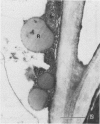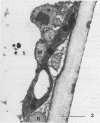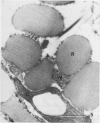Abstract
Electron micrographs of the mesophyll cells of guayule Parthenium argentatum Gray leaves show deposits of cis-polyisoprene (rubber) in the cytoplasm in the vicinity of mitochondria and chloroplasts and demonstrate that the rubber-synthesizing enzymes are present in guayule leaves. The terminal step in the synthesis of cis-polyisoprene from isopentenyl pyrophosphate (IPP) catalyzed by isopentenyl pyrophosphate cis-1,4-polyisoprenyl transferase has been demonstrated in crude leaf extracts by the enzymic incorporation of [14C]isopentenyl pyrophosphate into the polymer and the recovery of [14C]levulinic acid following ozonolysis. The rubber transferase activity in the crude extracts of guayule leaves was 5.8 nanomoles isopentenyl pyrophosphate incorporated per milligram protein per hour. This is the first description of the rubber transferase from a nonlaticiferous plant.
The specific activity (in units of nanomoles IPP converted per milligram protein per hour) of the partially purified enzyme following chromatography on diethylaminoethyl-cellulose columns was 41.7 units and contained 0.29 units of IPP isomerase activity and 0.08 units of farnesyl pyrophosphate synthetase activity. The rubber transferase requires reduced glutathione and Mg2+ for maximal activity. There was no incorporation of IPP into cis-1,4-polyisoprene in the absence of rubber particles as primer, and Langmuir isotherm plots showed that the specific activity of the enzyme was proportional to the concentration of the enzyme on the surface of the rubber particles. For a given rubber particle distribution, enzyme activity was proportional to time, IPP concentration, and rubber concentration. The addition of 0.4 millimolar dimethylallyl pyrophosphate to the rubber transferase reaction resulted in a 2-fold increase in the incorporation of IPP into rubber. A comparison was made of the relative activities of rubber transferase in different species of Parthenium, Ficus, and Euphorbia.
Full text
PDF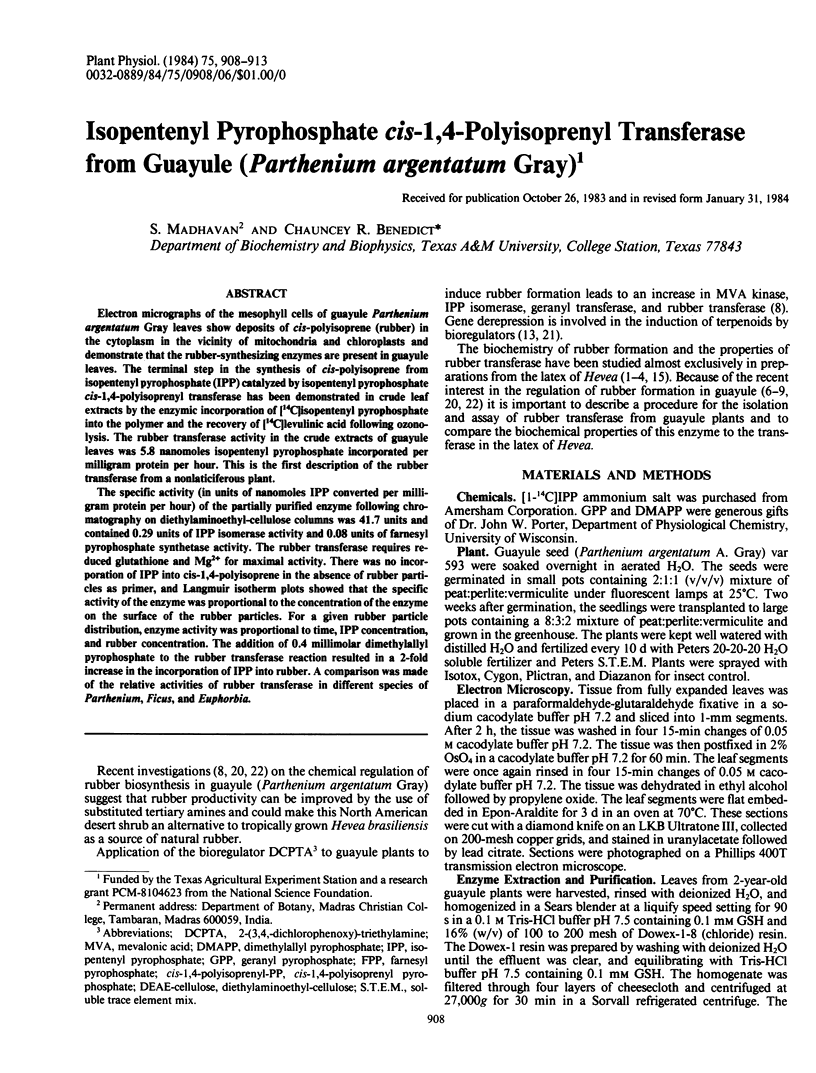
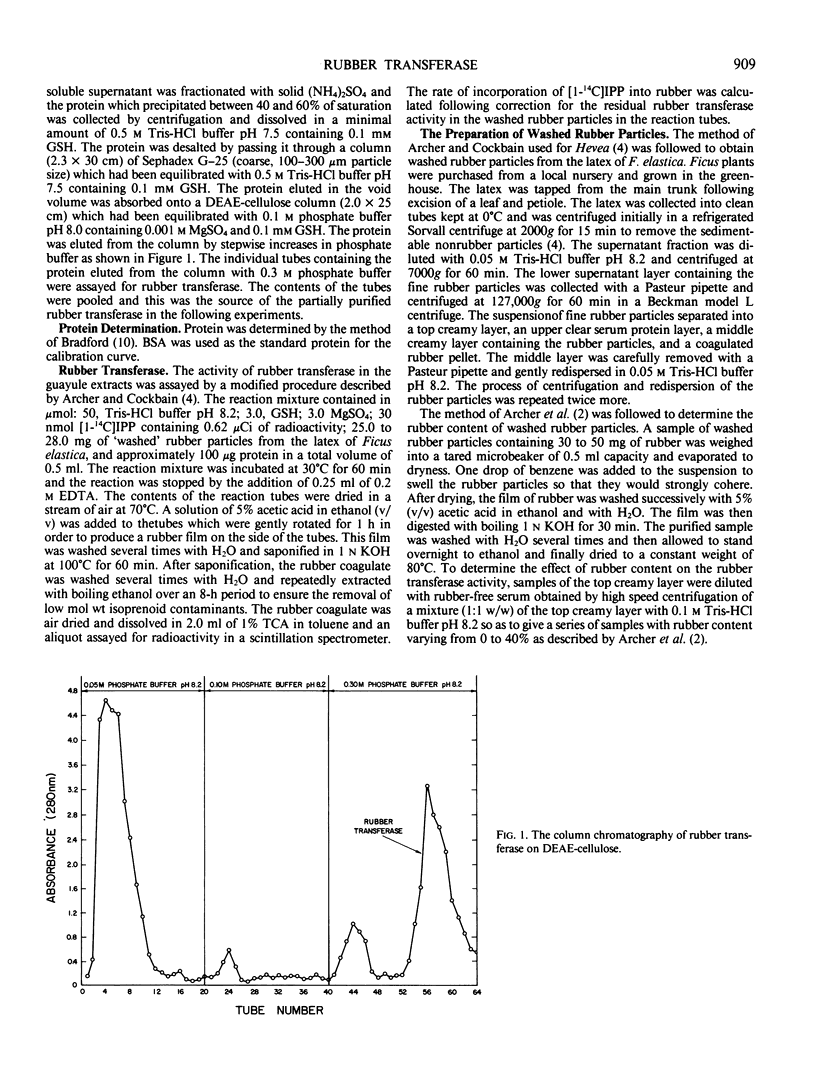
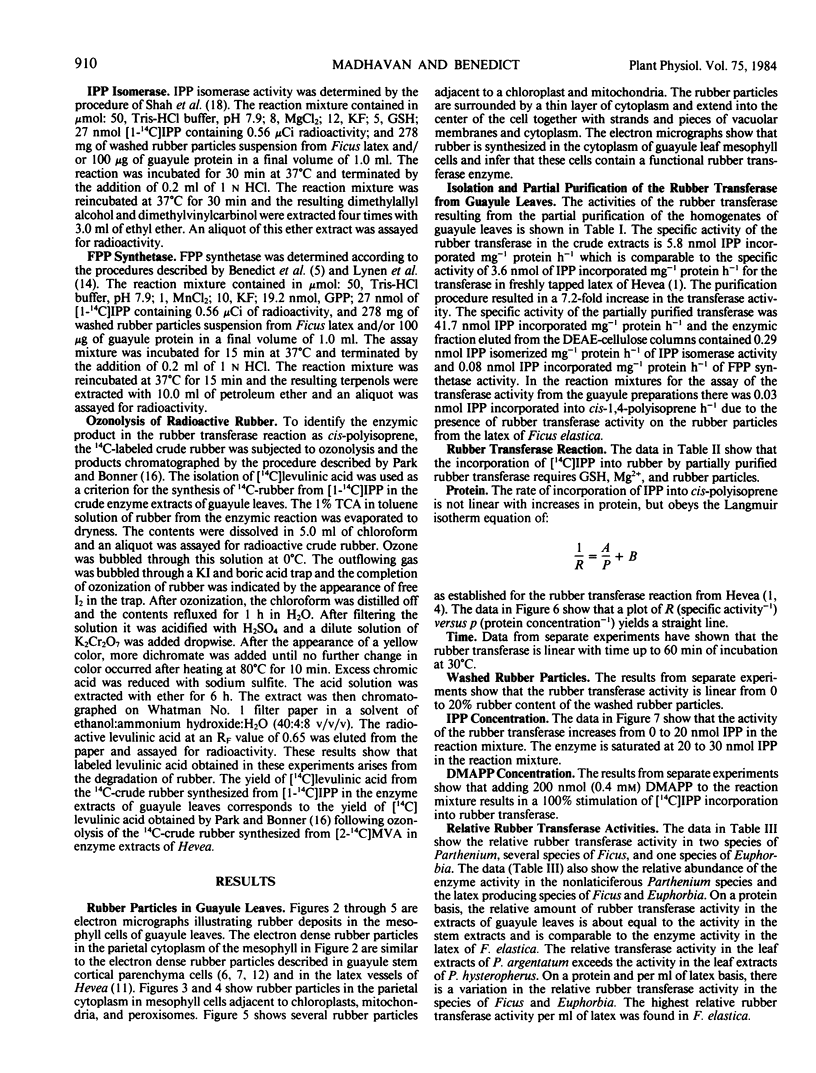
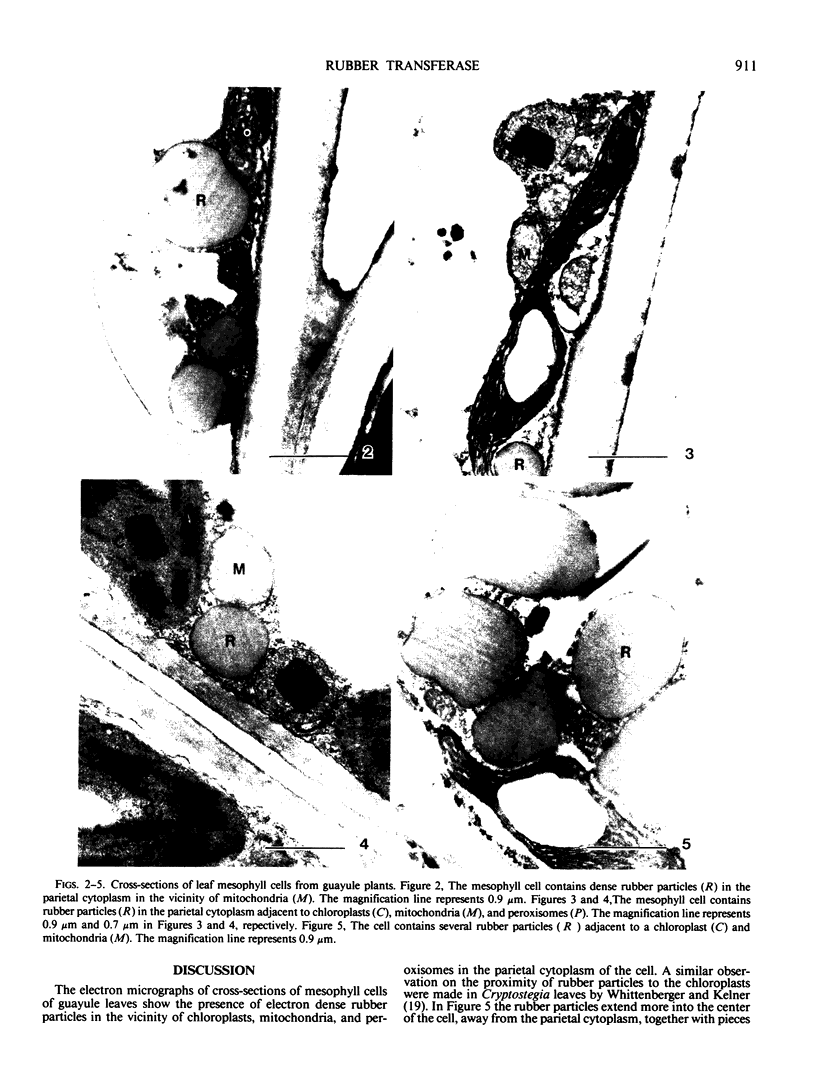
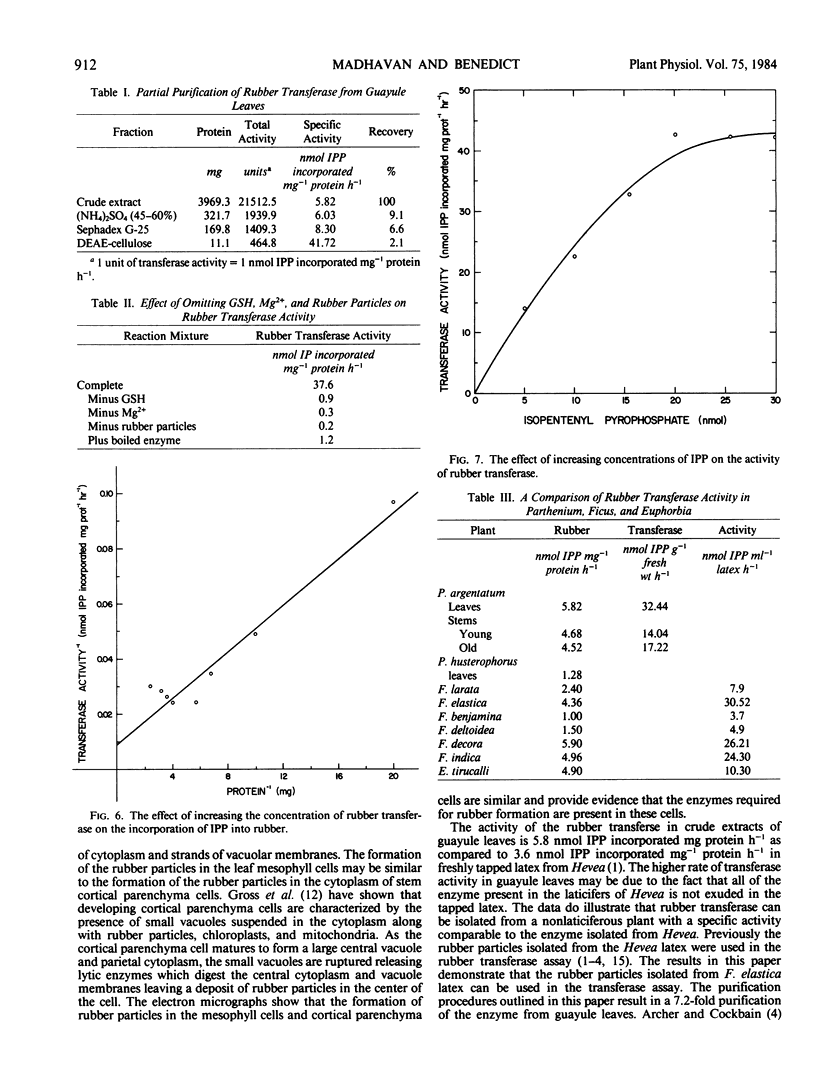
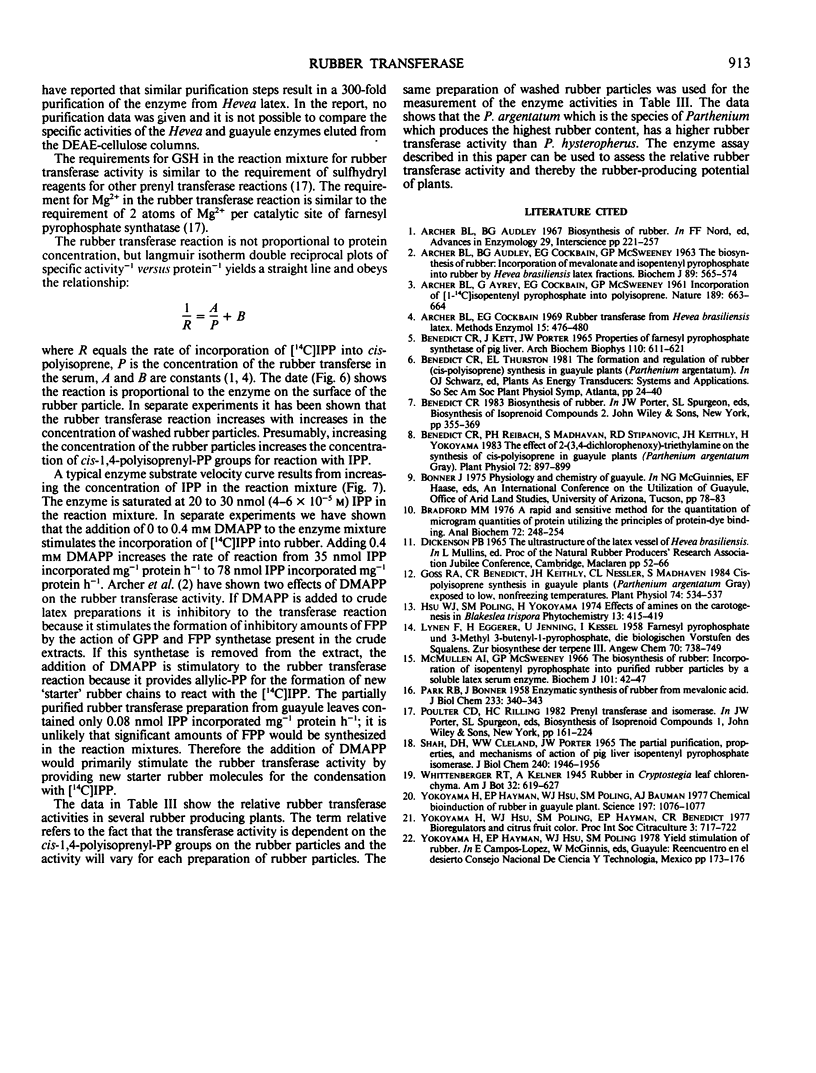
Images in this article
Selected References
These references are in PubMed. This may not be the complete list of references from this article.
- Archer B. L., Audley B. G. Biosynthesis of rubber. Adv Enzymol Relat Areas Mol Biol. 1967;29:221–257. doi: 10.1002/9780470122747.ch5. [DOI] [PubMed] [Google Scholar]
- Archer B. L., Audley B. G., Cockbain E. G., McSweeney G. P. The biosynthesis of rubber. Incorporation of mevalonate and isopentenyl pyrophosphate into rubber by Hevea brasiliensis-latex fractions. Biochem J. 1963 Dec;89(3):565–574. doi: 10.1042/bj0890565. [DOI] [PMC free article] [PubMed] [Google Scholar]
- Benedict C. R., Kett J., Porter J. W. Properties of farnesyl pyrophosphate synthetase of pig liver. Arch Biochem Biophys. 1965 Jun;110(3):611–621. doi: 10.1016/0003-9861(65)90457-1. [DOI] [PubMed] [Google Scholar]
- Benedict C. R., Reibach P. H., Madhavan S., Stipanovic R. V., Keithly J. H., Yokoyama H. Effect of 2-(3,4-Dichlorophenoxy)-triethylamine on the Synthensis of cis-Polyisoprene in Guayule Plants (Parthenium argentatum Gray). Plant Physiol. 1983 Jul;72(3):897–899. doi: 10.1104/pp.72.3.897. [DOI] [PMC free article] [PubMed] [Google Scholar]
- Bradford M. M. A rapid and sensitive method for the quantitation of microgram quantities of protein utilizing the principle of protein-dye binding. Anal Biochem. 1976 May 7;72:248–254. doi: 10.1006/abio.1976.9999. [DOI] [PubMed] [Google Scholar]
- Goss R. A., Benedict C. R., Keithly J. H., Nessler C. L., Stipanovic R. D. cis-Polyisoprene Synthesis in Guayule Plants (Parthenium argentatum Gray) Exposed to Low, Nonfreezing Temperatures. Plant Physiol. 1984 Mar;74(3):534–537. doi: 10.1104/pp.74.3.534. [DOI] [PMC free article] [PubMed] [Google Scholar]
- JACOBSON B., DAVIDSON E. A. Chemical oxidation of uridine diphosphate-glucose to uridine diphosphate-glucuronic acid. Nature. 1961 Feb 25;189:663–663. doi: 10.1038/189663a0. [DOI] [PubMed] [Google Scholar]
- McMullen A. I., McSweeney G. P. The biosynthesis of rubber: Incorporation of isopentenyl pyrophosphate into purified rubber particles by a soluble latex serum enzyme. Biochem J. 1966 Oct;101(1):42–47. doi: 10.1042/bj1010042. [DOI] [PMC free article] [PubMed] [Google Scholar]
- PARK R. B., BONNER J. Enzymatic synthesis of rubber from mevalonic acid. J Biol Chem. 1958 Aug;233(2):340–343. [PubMed] [Google Scholar]
- SHAH D. H., CLELAND W. W., PORTER J. W. THE PARTIAL PURIFICATION, PROPERTIES, AND MECHANISM OF ACTION OF PIG LIVER ISOPENTENYL PYROPHOSPHATE ISOMERASE. J Biol Chem. 1965 May;240:1946–1956. [PubMed] [Google Scholar]
- Yokoyama H., Hayman E. P., Hsu W. J., Poling S. M., Bauman A. J. Chemical bioinduction of rubber in guayule plant. Science. 1977 Sep 9;197(4308):1076–1078. doi: 10.1126/science.197.4308.1076. [DOI] [PubMed] [Google Scholar]



